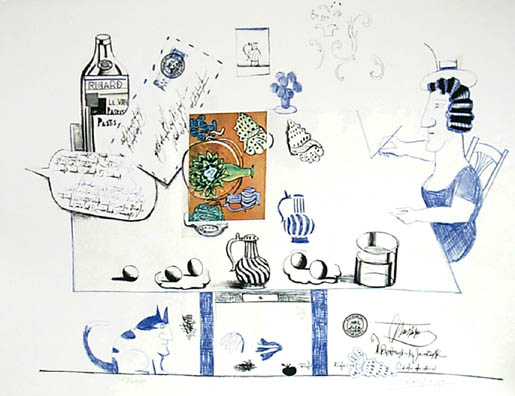Henri Matisse
"Henri Matisse: The Carnal Formula," Spike Art Quarterly n. 43 (Spring 2015): 83–87.
The postcard sits at the center of the table, beside an airmail envelope and a bottle of pastis. This arrangement, however, is a red herring: like Henri Matisse himself, Saul Steinberg's lithograph Matisse Postcard (1970) doesn't dote on the café table (after all, that's cubism's domain). The Postcard's real site is the drawing desk, cluttered with shells and vases, coffeepots and flowers, duplicated outside the card. There, they join other Matissean motifs: a fishless goldfish bowl, scalloped dishes, an arabesque flickering over the wall, remnants from The Parakeet and the Mermaid collected on the studio floor. They perform — undecidedly, simultaneously — as wandering citations of the postcard and as model objects for the image on it. Is Steinberg's scene a studio inventory or a doodle? A portrait of the workspace, or the working process? Well, both. That's Steinberg's wit, whose crowning gesture is to place a black-haired and behatted model in the draftman's seat. If Steinberg can telescope the interval between the artist's studio and the museum gift shop, it is not just because Matisse's still lifes seemed always already postcards — pleasing paintings composed by the artist who aimed to make art 'like a good armchair', offering consolation and repose. It is also because the dreamy, dilatable quality of the souvenir, incubating versions of itself in memory or in reproduction, is native to Matisse. It is as much a part of the construction of his paintings as the model is for Steinberg's lithograph. [...]

Saul Steinberg, Matisse Postcard, 1970
(From "Six Drawing Tables")
Lithograph, collage on paper; Ed. of 100
22" x 30"
Courtesy Adam Baumgold Gallery